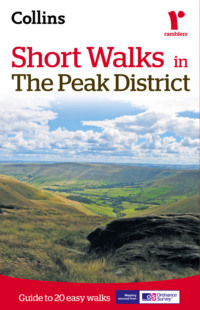Książki nie można pobrać jako pliku, ale można ją czytać w naszej aplikacji lub online na stronie.
Czytaj książkę: «Short walks in the Peak District»
Short Walks in
The Peak District

Guide to 20 easy walks
Contents
Cover
Title
Short Walk locations
Introduction
How to use this book
 Short walks
Short walks
walk 1: Derwent Moors
4¾ miles (7.6km)
walk 2: Combs
4 miles (6.4km)
walk 3: Peak Forest
4¼ miles (6.8km)
walk 4: Shatton Moor
4½ miles (7.2km)
walk 5: Carl Wark & Higger Tor
3¾ miles (6km)
walk 6: Padley Gorge
3¾ miles (6km)
walk 7: Birchen Edge
4 miles (6.4km)
walk 8: Miller’s Dale & Wormhill
5 miles (8km)
walk 9: Solomon’s Temple
4½ miles (7.2km)
walk 10: White Nancy
4 miles (6.4km)
walk 11: Dovedale
4½ miles (7.2km)
walk 12: Longnor Two Valleys Walk
4 miles (6.4km)
walk 13: Elton & Robin Hood’s Stride
3 miles (4.8km)
walk 14: High Tor & the Heights of Abraham
4½ miles (7.2km)
walk 15: Cromford & the High Peak Incline
3½ miles (5.6km)
walk 16: Tissington & Parwich
3¾ miles (6km)
walk 17: Ilam Hall
4½ miles (7.2km)
walk 18: Three Shire Heads
4 miles (6.4km)
walk 19: Viator’s Bridge, Milldale
2¼ miles (3.6km)
walk 20: Thor’s Cave
5 miles (8km)
Photo credits
Copyright
About the Publisher
walk 1, walk 2, walk 3, walk 4, walk 5, walk 6, walk 7, walk 8, walk 9, walk 10, walk 11, walk 12, walk 13, walk 14, walk 15, walk 16, walk 17, walk 18, walk 19, walk 20
Introduction

Walking in the Peak District
When walking in the Peak District you can encounter some quite different types of terrain. Probably the easiest walking of all is on the limestone plateau where stone stiles and green lanes indicate the way. In the dales, paths wander through shady woodland and follow bubbling trout rivers. In the north, the unpredictable weather makes navigation across the trackless moors quite difficult. Gritstone edges above the Derwent, or the lower heather moors, are more straightforward and the footpaths are easier to follow.
Walking is a pastime which can fulfil the needs of everyone. You can adapt it to suit your own preferences and it is one of the healthiest of activities. This guide is for those who just want to walk a few miles. It really doesn’t take long to find yourself in some lovely countryside. All the walks are five miles or less so should easily be completed in under three hours. Walking can be anything from an individual pastime to a family stroll, or maybe a group of friends enjoying the fresh air and open spaces of our countryside. There is no need for walking to be competitive and, to get the most from a walk, it shouldn’t be regarded simply as a means of covering a given distance in the shortest possible time.
What is the Peak District?
The title ‘Peak District’ is something of a misnomer. The name ‘Peak’, in fact, refers to a tribe who lived in the area in ancient times. In the year 924, a cleric writing about the hills and dales of what is now North Derbyshire, referred to the inhabitants as living in ‘Peaclond’ and the name seems to have stuck.
There are really two Peak Districts – Dark and White. The two areas are so completely different that, when standing on the breezy limestone plateau of the White Peak, it is hard to imagine that the untamed wilderness of Bleaklow and Kinder Scout are not far away. Broadly speaking, the Peak District can be sub-divided into six distinct areas;
• The most northerly is the wildest and covers the moors above Saddleworth and the Longdendale Valley with the huge spread of Bleaklow filling the space between Longdendale and the Snake Pass.
• Kinder Scout is a vast boggy plateau bordered to its south by Edale and the graceful sweep of the Mam Tor – Rushup Edge Ridge.
• To the east, rising above the Derwent Valley, there is a long escarpment which is clearly defined by a series of gritstone edges backed by heather moorland.
• In the west, gritstone crags range from The Roaches above Leek to Windgather Rocks and Castle Naze on the northern limits. High open moors offer miles of lesser known walking. Tranquil wooded valleys cutting the western moors are excellent places to walk on hot summer days.
• Limestone makes its most northerly appearance in dramatic cliffs and knolls above Castleton, a place of caves and ancient lead mines. South of Castleton are some of the highest villages in the White Peak. They can expect to be cut off by deep snow for several days during most winters.
• The limestone plateau to the southwest of the A6 is incised by deep valleys and is judged by many to be the prettiest part of the Peak. It is certainly a zone of contrasts where the lush pastures of the rolling uplands have been grazed by cattle since time immemorial. Rivers run pure and clear and they are full of lively trout.
People came early to the Peak. Settling first on the treeless limestone plateau, they left mysterious mounds and stone circles. The circle at Arbor Low between Hartington and Youlgreave was probably the most important. Certainly its surrounding earthworks indicate its significance. Arbor Low is unique as the stones lie flat, unlike the more familiar uprights associated with other circles.
Darmowy fragment się skończył.

